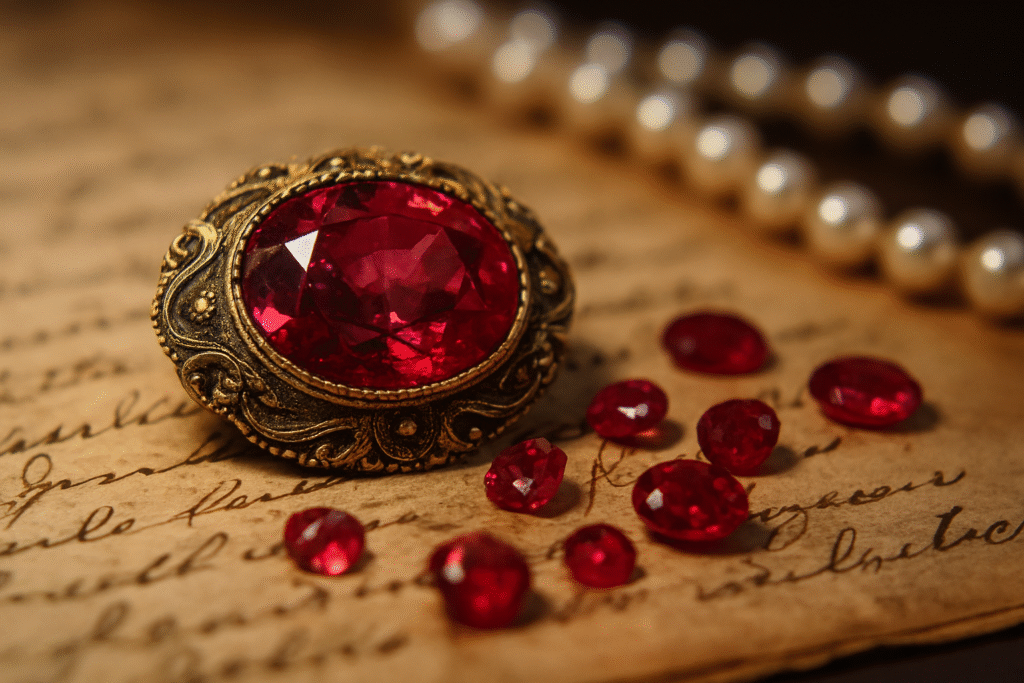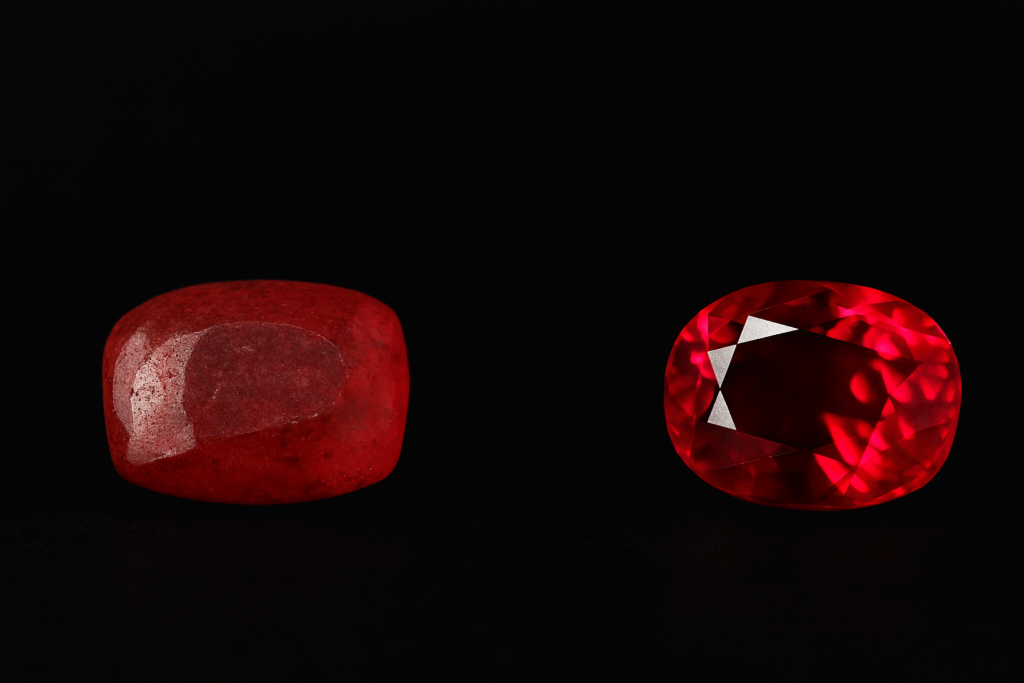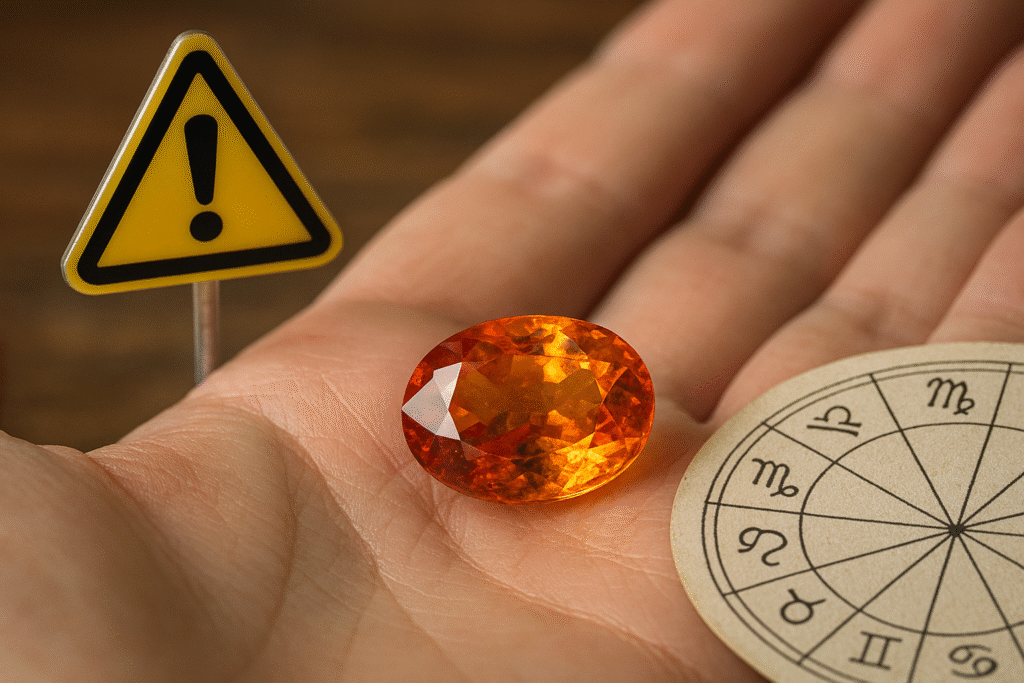Table of Contents
- Introduction
- What Is the Hidden Value in Old Cut Rubies?
- Why Recutting Old Cut Rubies Can Lower Value
- Auction Results That Prove the Value of Vintage Cuts
- Expert Advice on Preserving Vintage Ruby Cuts
- FAQs
Introduction
The hidden value in old cut rubies often surprises families. Many inherit a cushion or European cut ruby and immediately consider recutting. However, pausing to evaluate the gem first can reveal hidden benefits. In fact, preserving the original cut often increases both historical significance and market value. Additionally, collectors consistently pay higher prices for gems that retain their antique charm.
What Is the Hidden Value in Old Cut Rubies?
First, old cuts reflect craftsmanship from earlier centuries. They were designed for candlelight, which gives them a warm glow. As a result, these rubies stand apart from modern brilliants. Moreover, collectors prize authenticity, and auctions consistently confirm the strong demand for vintage cuts. Therefore, keeping the original style can significantly impact resale value.
Why Recutting Old Cut Rubies Can Lower Value
When you recut a ruby, you actively reduce carat weight. Even a 10–15% loss can significantly lower resale prices. Furthermore, reshaping erases the historical style that makes the gem special. Because of that, many experts recommend preserving the original cut. For example, reshaped heirlooms often lose market appeal despite improved sparkle.
Auction Results That Prove the Value of Vintage Cuts
- Sotheby’s sold a Burmese cushion ruby for 35% more than a recut equivalent.
- Likewise, family heirlooms I appraised in India lost half their market value after reshaping.
- In fact, market research shows vintage rubies in original cuts typically sell 20–40% higher than modified stones.
Expert Advice on Preserving Vintage Ruby Cuts
With over 40 years of global gemstone experience, I have learned this: “The key is to respect the cut your gemstone already carries.” Additionally, preserving old cuts protects both history and market value. Finally, collectors recognize and reward authenticity, which modern recuts rarely match.
Related Articles:
- To buy gems wisely, see Gemstone Buying Pitfalls Every Collector Should Avoid.
- To understand jewelry quality, visit Understanding BIS Hallmark: What It Means for Your Jewellery.
Explore More Here:
Auction data from Sotheby’s and Christie’s confirms ongoing demand for old cuts.
FAQ
Q1. What is the hidden value in old cut rubies?
The hidden value in old cut rubies comes from history, craftsmanship, and rarity. Vintage cuts often sell 20–40% higher than recut stones.
Q2. Should I recut my old ruby?
No, unless it is badly damaged. Recutting actively reduces carat weight and diminishes historical value.
Q3. How can I identify an old cut ruby?
Look for cushion-like shapes, high crowns, and deep pavilions. A gemologist can verify authenticity.
Q4. Where can I sell an old cut ruby?
Sell through auction houses or certified dealers that value vintage cuts.
Q5. Why do collectors pay more for old cut rubies?
Collectors actively seek authenticity and rarity. Original cuts preserve historical craftsmanship.
Small Luxury Hotels FAQ
Introduction
This small luxury hotels FAQ answers common questions about boutique stays. It explains definitions, differences with large chains, and which services to expect. In addition, it covers family options, sustainability, and tips on finding the right property.
What defines a small luxury hotel?
- Fewer than 100 rooms.
- Personalized attention and privacy.
- Strong links to local design.
- Locations in unique urban or rural areas.
As a result, travelers often choose them for a more intimate experience. Moreover, their distinctive style sets them apart from standardized hotels.
Why choose a small luxury hotel?
Personal service
Staff remember guest details, therefore creating a sense of familiarity.
Calm spaces
Unlike large hotels, these properties feel quieter, so you can relax more easily.
Local culture
For example, menus highlight regional produce, and interiors reflect local crafts.
In addition, many guests return because the experience feels authentic.
How do small luxury hotels differ from large chains?
Guest experience
Small hotels provide tailored attention, while chains rely on uniform systems.
Property identity
Each boutique hotel has its own theme. On the other hand, large chains repeat formats worldwide.
Dining approach
Menus change seasonally and locally. Therefore, guests enjoy fresh variety instead of standard global menus.
Are small luxury hotels only for leisure stays?
Business features
- Lounges double as meeting rooms.
- Private dining options support work dinners.
Digital needs
- Fast Wi-Fi supports remote work.
- Quiet spaces help concentration.
Because of these advantages, small luxury hotels appeal to both business and leisure travelers.
What services can you expect?
- Concierge services for tours and dining.
- Fine dining menus with seasonal ingredients.
- Spa and wellness treatments.
- Added extras like minibars and welcome gifts.
Moreover, services shift depending on location. For example, a city hotel might offer cultural tours, while a rural retreat offers farm experiences.
Are small luxury hotels family-friendly?
Options for families
- Connecting rooms for parents and children.
- Child-friendly amenities such as menus or games.
Adults-only stays
- Some properties focus on privacy.
- Guests find peaceful, child-free environments.
Therefore, always check booking policies, because each hotel sets its own approach.
Do these hotels support sustainability?
Sourcing and dining
Farm-to-table meals reduce transport impact. In addition, guests enjoy fresher produce.
Environmental focus
Plastic use is restricted, while refillable bottles are encouraged. Smart energy systems reduce wastage.
Local involvement
Hotels support the community by hiring regionally. As a result, growth extends beyond the property.
How do you find the right small luxury hotel?
Define needs
Decide if food, spa, culture, or privacy is your top priority.
Check guest feedback
For example, repeat reviews about service often signal consistency.
Compare value
Packages may include meals, transfers, or early check-in. Therefore, higher prices can still deliver stronger value.
Are small luxury hotels worth the price?
Value of service
Guests pay for attention, comfort, and privacy. Moreover, experiences feel tailored and unique.
Extras add value
Some hotels include exclusive experiences or benefits. Finally, weigh these extras against nightly rates.
As a result, many travelers feel these hotels justify their price when quality matters most.




